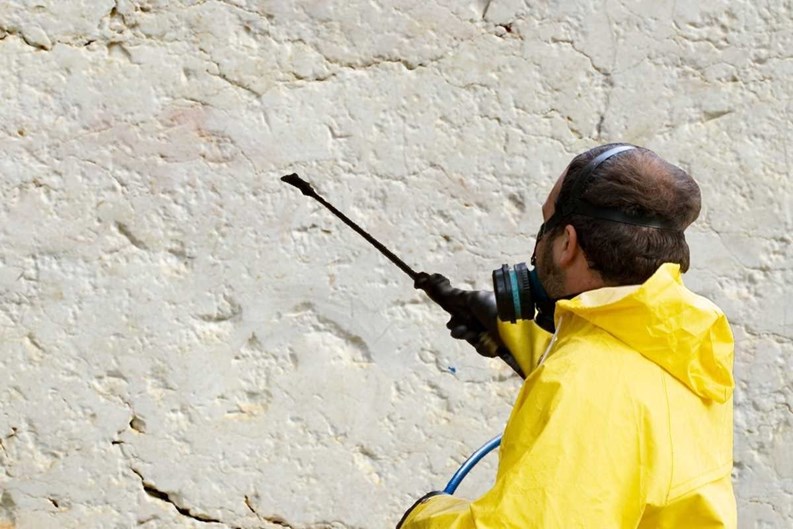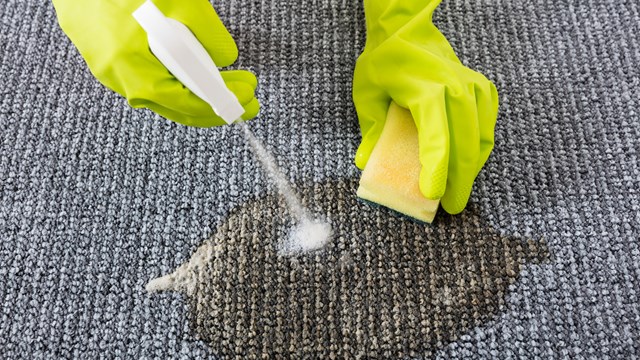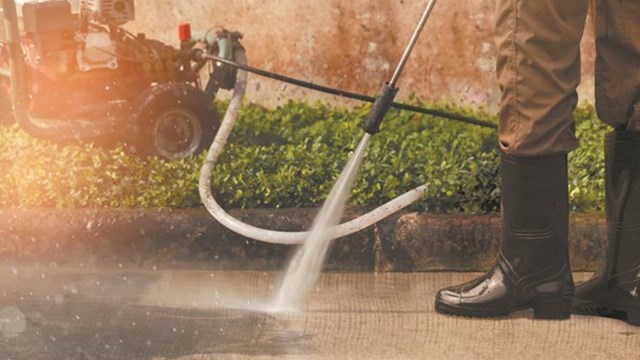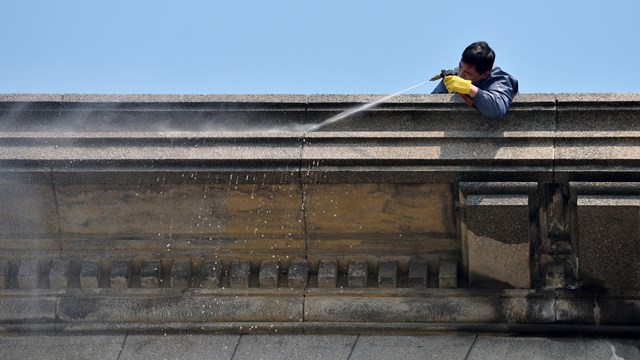Living in New York City can be something of a dirty job. Thanks to the hustle and bustle of big city living, the task of cleaning off months (or years) of accumulated grime and dirt from the exterior of a residential building takes much more than just a scrub-brush and a bottle of Windex; it requires professional help. The task is not just a labor-intensive job—it also calls for extensive knowledge of building materials, cleaning products and cleaning methods.
Removing the Dirt
For residents of co-ops and condos, knowing when, how and why or why not to have the exterior of their building cleaned could be a matter of dollars and cents but it also should be about what makes common sense. Most buildings would find it unnecessary to clean their building’s entire exterior each month, but some might want it done biannually, while others could allow the façade to darken for years before tending to it. It all really depends upon a building community’s perceptions, needs and budget.
Knowing the causes of exterior sediment and the cleaning methods used to deal with it can enable residents to take a realistic approach to the problem of keeping their building’s façade looking sharp. It’s hard to say what creates the most stains and grime on buildings: air pollution, dust from building equipment, car exhaust, subway soot...the list goes on and on. Facades are also soiled by atmospheric conditions like acid rain, and the buildup of dirt on a building over time can dull architectural details and lessen the overall beauty of the structure.
“Before 1930, they were burning coal in all these buildings, and the air quality was much worse. It stained the buildings,” says Andrew Wist, president of Standard Waterproofing in the Bronx. “Today, traffic pollution still causes carbon stains on buildings.”
Aside from looking terrible, some long-term problems may be associated with letting dirt and grime accumulate on your building. That dirt can create a sealing barrier that won’t allow the building exterior to “breathe,” and thus, cause problems such as water retention. Also, calcium and sulfates left on a building facade create acidic conditions and salts which can penetrate and cause deterioration to the masonry and underlying materials.
“Heavily soiled facades conceal underlying conditions, such as deteriorated mortar joints, which can result in moisture penetrating the facade and causing ‘freeze/thaw’ damage to the masonry and corrosion to underlying steel and reinforced concrete structural elements,” says Michael Yates, president of Yates Restoration in the Bronx.
Other, less-tangible effects of grime and stains on a building’s exterior include an erosion of residents' pride of ownership, as well as a less-than-great first impression for prospective buyers. Curb appeal is a real factor which can have a major impact on a person’s decision to buy or not buy into a particular building. A structure with a clean, sparkling exterior, free from grime and stains, will be more appealing to both the residents who live in it as well as those considering buying into it.
Cleaning Frequently
How often a building’s exterior should be cleaned varies, based upon a number of factors, including how long it’s been since the job was done, how well the job was done previously, what the façade is made of, the building’s budget and other considerations. For some communities, an exterior cleaning can be done in stages, with just the front façade being professionally cleaned on a regular basis, and the rest of the exterior getting the once-over less frequently.
Periodic facade cleaning is recommended by professionals and will vary based on factors such as location of the building, exposure to atmospheric contaminants such as exhaust and acid rain, as well as the type of construction. Limestone, granite, brick and concrete are cleaned in different ways, depending upon the severity of grime, and the cleaning methods chosen by the contractor.
“We recommend that each facade be cleaned [all at once] without phasing to minimize variability in the final appearance,” says Yates. “Otherwise, changes in conditions such as temperature and humidity, as well as continued exposure to contaminants between phases, can create a ‘banding’ effect” on the building,” he says.
Generally speaking, contractors across the board use the same arsenal of methods to clean buildings. Depending upon the job, varying combinations of high and low pressure water, detergents, strippers and acidic cleaners are used with spray bars and brushing to achieve the desired effect. It's sometimes impossible to tell whether a given approach will work without testing it on a small, discrete patch of the exterior first. “The final method for cleaning a building's facade should be chosen only after performing field tests to determine the mildest approach that is effective without causing damage to the building's façade,” Yates says.
The frequency of cleanings and what method is used also varies from brick to limestone to concrete. “Harder materials, such as some types of brick, concrete, and granite, may require frequent applications of acidic restoration cleaners, which must then be properly neutralized to avoid ‘burning’ of the treated surfaces,” Yates says. “In the case of softer materials such as limestone and some types of bricks, frequent applications could be required or even poultices, which utilize restoration cleaners in conjunction with packs of diatomaceous earth to draw the staining out of the brick or stone. Other materials such as some types of molded bricks can require cleaning less frequently, and with gentler methods—sometimes forgoing restoration cleaners completely in favor of a pure water soaking. This method involves the contractor attaching a soaking system to the building’s façade at the rooftop, then allowing the apparatus to wet the façade of the building continuously with a very low-pressure spray for a day or so. Afterward, grime is easily power-washed off the exterior surface.
Of course, one potential problem with this method is water infiltration. Needless to say, it's crucial that a qualified contractor be brought in to do the work, and that the contractor must monitor the building’s envelope to ensure that water doesn’t get into the building around the windows or elsewhere.
Graffiti is an issue of particular concern to urban dwellers, and requires a particular kind of expertise to get rid of. Generally, a pressure-washer is used in conjunction with chemicals to remove the paint and marker scrawl of graffiti on the exterior of a building. Graffiti may also be removed with specially-designed restoration paint strippers, says Yates.
Greener Methods
The processes and products used to clean building exteriors have changed a lot over the years, and now the chemicals used are far less caustic than in years past. While cleaning chemicals in the past would leave streaks on windows they came into contact with, newer chemicals will not. Even so, Wist says his company always covers windows when doing an exterior cleaning. The windows are covered with a liquid plastic that doesn’t harm them and which can be peeled off when the job is done.
How much it costs to get your building cleaned depends on the type of building facade being cleaned and the severity and type of contamination. While it depends upon the building, costs for exterior cleaning tend to run from $5 to $6 per square foot.
Cost is also influenced by factors such as what types of scaffolding and site protection are required, as well as protection of adjacent surfaces such as windows and metal work. In some cases, a sidewalk bridge will be required and a water-collection system will be needed to ensure that none of the chemically-tainted or grimy water makes it onto the sidewalk or street, or into the sewer system.
While this procedure might seem extreme, city inspectors will come to the work site and could fine the contractor or building if the cleaning process isn’t being done properly. “They come in mobile units and check it,” Wist says.
The processes and products used to clean building exteriors have changed a great deal over the years. Decades back, some cleaners used for the work would literally burn the hair off the top of your head if they made contact. Nowadays, the cleaners can still burn you, but not nearly so severely.
“Green” movement innovations and needs have had other impacts on the kinds of chemicals and methods used to clean buildings. “Restoration cleaners have evolved in response to environmental concerns and regulations, with new compliant formulations now available,” Yates says. “Use of harsher acidic cleaners is still sometimes the only effective approach to cleaning certain facades, and in such cases the runoff must be properly treated and neutralized before going into the city sewer system.”
William Rivera, owner of A & M Waterproofing in Brooklyn, says one of the newest devices for cleaning a building’s exterior is itself reusable. The new Sponge Jet System involves spraying tiny reusable sponges against the building’s exterior to remove the dirt. The reusable sponges don’t hurt the windows or the façade, but they remove the grime.
“It’s expensive to clean a building, but a lot of the best buildings do it because it looks nice. Most buildings do it because they want apartment prices to stay high and they want the building to look nicer,” Rivera says.
To keep at least the ground floor of the building’s exterior looking its best between professional scrubbings, the staff should power-wash the exterior at least once a month. Some buildings have such a quick cleaning done more often.
The experts agree that picking the right contractor is one of the most important aspects of undertaking an exterior cleaning of a residential building. A board should truly vet the contractor before hiring them, and make sure the company has done the same kind of work for other clients. Then the board should check how well that work was done.
Finally, the board should check the contractor’s insurance papers for the work to be done on the building—or have the building’s attorney eyeball the papers—to ensure that the insurance covers everything that it should. If it doesn’t and things go wrong with the job, the building’s residents could be left holding the bag.
Jonathan Barnes is a freelance writer and regular contributor to The Cooperator.







Comments
Leave a Comment